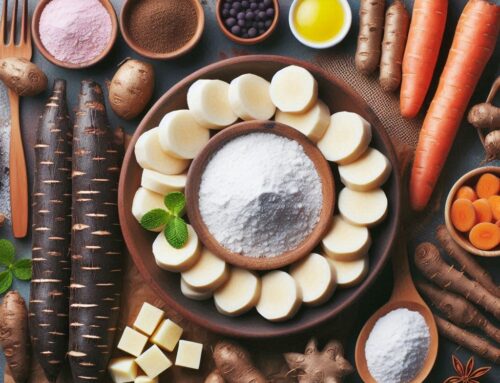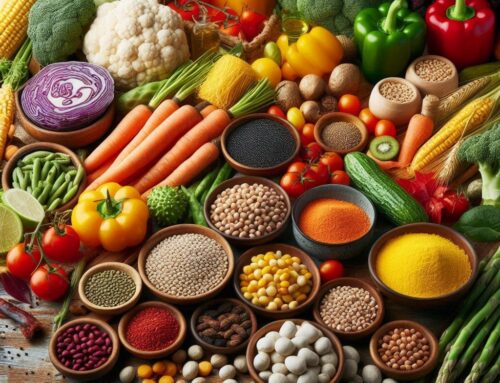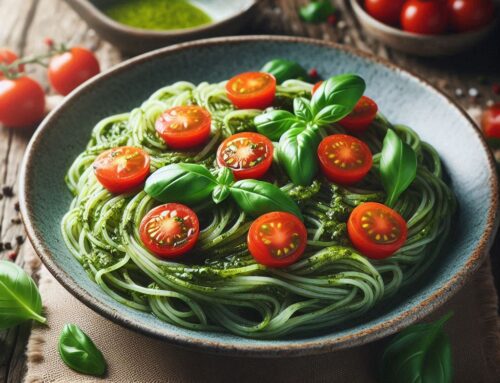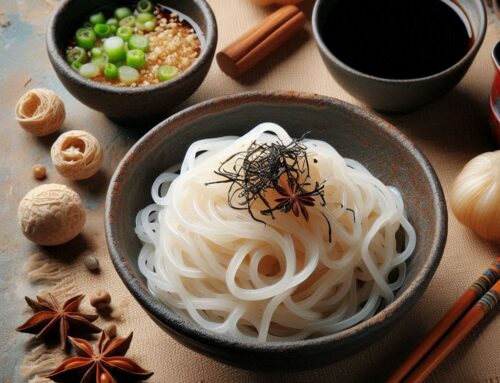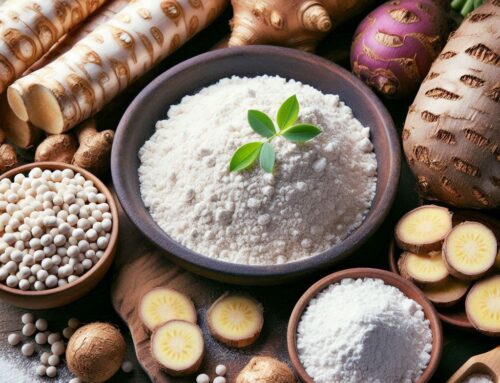
Introduction to Konjac: Understanding the Basics
Konjac, a plant native to parts of Asia, has gained significant attention in recent years due to its versatile uses and health benefits. But what exactly is konjac? Scientifically known as Amorphophallus konjac, this perennial plant thrives in subtropical and tropical regions, particularly in countries like Japan, China, and Indonesia. The key component of the konjac plant is its corm—a tuber-like structure that resembles a bulb—which is rich in glucomannan fiber.
The benefits of konjac are numerous. Its high fiber content makes it an excellent dietary supplement for those looking to improve digestive health or manage weight. Glucomannan absorbs water and expands in the stomach, promoting a feeling of fullness which can aid in reducing overall calorie intake. Additionally, konjac has been linked to improved cholesterol levels and better blood sugar control.
Understanding the basics of konjac cultivation involves recognizing its need for warm climates with plenty of rainfall. The plant requires well-drained soil rich in organic matter to thrive. Typically planted during the spring months after the last frost has passed, it takes about two years for the corms to mature fully before they can be harvested.
As more people become aware of its unique properties and potential health advantages, interest in cultivating and consuming konjac continues to grow around the world. Whether you’re considering adding it to your diet or exploring it as a crop option, understanding these basics provides a solid foundation for appreciating this remarkable plant.
Ideal Growing Conditions for Konjac Plants
Konjac plants, known for their unique tubers used in various culinary and health products, thrive under specific growing conditions that are crucial for optimal development. Understanding the konjac climate needs is essential for successful cultivation. These plants prefer a warm and humid environment, thriving best in subtropical regions. The optimal temperature for growing konjac ranges between 70 to 85 degrees Fahrenheit (21 to 29 degrees Celsius). This temperature range supports their growth cycle and ensures healthy tuber development.
When it comes to soil requirements for konjac, well-draining soil is paramount. Konjac plants favor loose, fertile soil rich in organic matter, which facilitates proper drainage and prevents waterlogging—a condition detrimental to the plant’s health. A slightly acidic to neutral pH level between 6.0 and 7.0 is ideal.
Sunlight and water needs are also critical factors in cultivating konjac successfully. These plants require partial shade as they can be sensitive to direct sunlight exposure; thus, filtered light or dappled shade mimics their natural forest floor habitat effectively. Consistent moisture is vital; however, overwatering should be avoided as it can lead to root rot. Regular watering that keeps the soil consistently moist but not soggy will support robust growth.
By adhering to these guidelines on climate preferences, soil composition, sunlight exposure, and watering practices, growers can create an environment conducive to flourishing konjac plants that yield high-quality tubers suitable for various uses.
Step-by-Step Guide to Planting Konjac Tubers
Konjac tubers, known for their versatility and nutritional benefits, are an excellent addition to any garden. They can be used in various culinary applications, particularly in Asian cuisine where they are prized for their low-calorie and high-fiber content. Here’s a step-by-step guide to planting konjac tubers that will help you cultivate this unique plant successfully.
- Selecting the Right Site: Choose a location that receives partial shade, as konjac thrives in environments with filtered sunlight. Ensure the soil is well-draining, rich in organic matter, and slightly acidic to neutral in pH.
- Preparing the Soil: Before planting, loosen the soil to a depth of at least 12 inches and incorporate compost or well-rotted manure to enhance soil fertility. This preparation ensures that your konjac tubers have access to essential nutrients and adequate drainage.
- Planting Tubers: Plant konjac tubers during early spring when the risk of frost has passed. Place each tuber about 4 inches deep into the soil with its growing point facing upwards. Space them approximately 18-24 inches apart to allow room for growth.
- Watering Regimen: Maintain consistent moisture levels by watering regularly but avoid waterlogging the soil as this can cause rot. Konjac plants prefer moist conditions but require good drainage.
- Fertilization Tips: Apply a balanced fertilizer every four weeks during the growing season to support healthy growth and development of your konjac plants.
- Harvesting Guidance: After about two years of growth, your konjac tubers will be ready for harvest once their foliage dies back naturally in late autumn or early winter.
By following these steps, you’ll be well on your way to successfully cultivating konjac tubers that can be used in various dishes or processed into flour for culinary innovations like shirataki noodles or gelatinous desserts!
Caring for Your Konjac Plants: Maintenance Tips
Caring for your konjac plants requires attention to detail and a consistent maintenance routine to ensure healthy growth. One of the most crucial aspects is establishing an appropriate watering schedule for konjac plants. These plants prefer well-drained soil and should be watered deeply but infrequently, allowing the soil to dry out between waterings. Overwatering can lead to root rot, so it’s essential to monitor soil moisture levels carefully.
Fertilizing is another key component in promoting robust growth. Fertilizing tips for healthy growth include using a balanced, slow-release fertilizer during the growing season. This helps provide essential nutrients without overwhelming the plant. It’s advisable to follow the manufacturer’s instructions on fertilizer application rates and frequency.
Pest control in konjac farming is vital as these plants can be susceptible to various pests such as aphids and spider mites. Regularly inspecting your plants for signs of infestation and applying organic or chemical treatments as needed can help keep pest populations under control.
Pruning and maintenance of konjac leaves are also important tasks that contribute to plant health. Removing dead or damaged leaves not only improves appearance but also allows the plant to focus its energy on new growth. Routine maintenance ensures that your konjac plant remains vibrant and productive throughout its life cycle.
Harvesting and Storing Konnyaku (Konjac) Tubers Successfully
Harvesting konnyaku tubers, also known as konjac, requires careful timing and technique to ensure the best yield. Knowing when to harvest konnyaku tubers is crucial; typically, this occurs in late autumn after the plant’s leaves have yellowed and died back. This natural sign indicates that the tubers have matured and are ready for harvesting.
When it comes to harvesting techniques, it’s essential to handle the tubers gently to prevent bruising or damage. Use a spade or garden fork to carefully lift the soil around the plant, gradually loosening it until you can easily extract the tuber without force. Ensuring minimal disturbance during this process helps maintain the quality of your harvest.
Once you’ve successfully harvested your konnyaku tubers, proper storage is key to preserving their quality for future use. Clean off any excess soil and allow them to dry in a cool, shaded area with good ventilation for a few days. After drying, store them in a cool, dark place with consistent humidity levels. Proper storage not only maintains their freshness but also maximizes yield by preventing spoilage.
By following these guidelines on when and how to harvest konnyaku tubers and storing them properly, you can enjoy an abundant supply from your plants while maintaining their quality for culinary or commercial purposes.
Troubleshooting Common Problems When Growing Konjac
Growing konjac can present several challenges, but understanding how to troubleshoot common problems can significantly enhance your success. One of the primary concerns is disease management in konjac plants. It’s crucial to regularly inspect your plants for signs of fungal infections or bacterial diseases, which often manifest as discolored leaves or wilting. Implementing a routine spraying schedule with appropriate fungicides and maintaining proper plant spacing can help prevent these issues.
Common pests affecting konjac plants include aphids and spider mites, which can severely impact plant health if not addressed promptly. Regularly check the undersides of leaves for these pests and consider introducing natural predators like ladybugs or using organic insecticidal soaps to keep their populations in check.
Dealing with poor growth or yield issues often requires a careful assessment of soil quality and nutrient levels. Konjac thrives in well-draining soil rich in organic matter, so conducting a soil test and amending it with compost or balanced fertilizers might be necessary.
Environmental challenges such as temperature fluctuations or inadequate humidity levels also affect konjac growth. To mitigate these factors, ensure that your growing area has consistent temperature control and sufficient moisture levels—using mulch can help retain soil moisture during dry periods.
By addressing these common problems with informed strategies, you can foster healthier konjak plants and improve overall yields.


